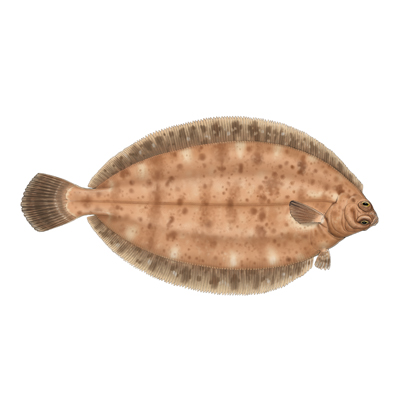

Witch or Witch Flounder is a small, oval, right eyed flatfish species with prominent eyes related to plaice that are mainly found on soft-bottom habitats at depths around 100 to 400 metres, witch's diet consists of crustaceans, worms, brittle stars, and fish.
Cornish Vessels landing to Cornish Ports
Beam trawls are nets attached to a steel beam that holds the net open. The belly of the net is made of chains and the upper surface of the net is mesh. Beam trawlers pull two nets along the seabed simultaneously.
Learn moreCornish Vessels landing to Cornish Ports
Demersal trawls are large nets that are pulled through the water with the bottom edge of the net touching the seabed. At each edge the net is pulled open by metal ‘trawl doors’. Sometimes referred to as Otter trawling.
Learn moreCornwall Good Seafood Guide rates fish on sustainability using a scale of 1 to 5.
1, 2 and 3 are recommended, Fish to avoid are rated 5.
We use the system devised by the Marine Conservation Society (MCS) so our scores are comparable with the scores produced by MCS for the UK and fisheries from all around the world. For more information on scoring click here.
Witch is common in the northern North Sea, west of the British Isles, in Icelandic waters and along the North American east coast. It is a right-eyed flat fish (both eyes on the right-hand side of the body) belonging to the same family as plaice. Witch spawn in summer, have a slow growth rate, and reach sexual maturity in 3-4 years. Witch on average live for about 14 years and can grow to a maximum size of 60cm, but the maximum reported age is 25 years. The species is mainly found on soft sea bottoms, mostly clay or clean sand, around 100-400 m depth. Their main diet consists of crustaceans, worms, brittle stars and fish. They have a moderate to high biological vulnerability 68%. (Cheung et al 2005 source www.fishbase.org).
There has been little study of this stock in Cornish waters. Ices say that although they have little information fishing pressure on this species is too high. Landings to Cornish ports have decreased from 100 tonnes in 1993 to just over 20 tonnes in 2013 but this may be in part due to decreased effort of beam trawlers.
There is no control on the quantities of witch caught in Cornish waters. There is no EU minimum landing size but within Cornish waters there is a minimum landing size for witch of 28cm (Cornwall Inshore fisheries and Conservation Authority).
Witch are caught by demersal trawl and beam trawl in Cornish waters.
MMO landings data
Project inshore pre assessment database
ICES advice 2014
Cheung, W.W.L., T.J. Pitcher and D. Pauly, 2005. A fuzzy logic expert system to estimate intrinsic extinction vulnerabilities of marine fishes to fishing. Biol. Conserv. 124:97-111






Cornwall Good Seafood Guide is underpinned by the Marine Conservation Society (MCS) Good Fish Guide. The first UK consumer guide to sustainable seafood. For more information visit www.fishonline.org
Cornwall Good Seafood Guide is here to help us all make sustainable seafood choices. Choices that will help us keep the oceans healthy and Cornish fishers' futures safe. This website is funded by Cornwall Wildlife Trust. If you would like to make a meaningful difference to the health of our oceans, please consider making a donation to the Cornwall Wildlife Trust Ocean Emergency fund. Your donation will help safeguard these remarkable environments, ensuring that they continue to thrive for generations to come. Together, we can be stewards of the seas and champions for a healthier, more sustainable future.